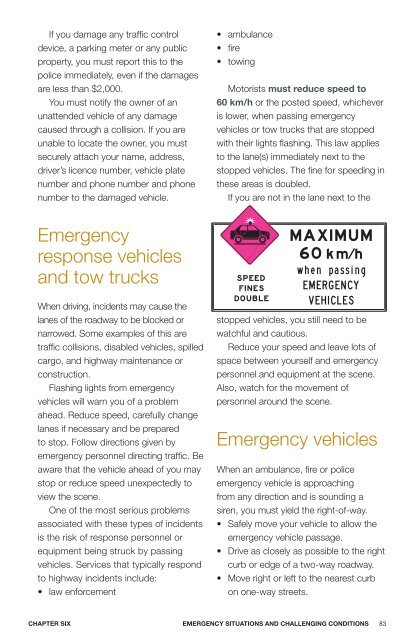DRIVER’S GUIDE
1POl7Ob
1POl7Ob
You also want an ePaper? Increase the reach of your titles
YUMPU automatically turns print PDFs into web optimized ePapers that Google loves.
If you damage any traffic control<br />
device, a parking meter or any public<br />
property, you must report this to the<br />
police immediately, even if the damages<br />
are less than $2,000.<br />
You must notify the owner of an<br />
unattended vehicle of any damage<br />
caused through a collision. If you are<br />
unable to locate the owner, you must<br />
securely attach your name, address,<br />
driver’s licence number, vehicle plate<br />
number and phone number and phone<br />
number to the damaged vehicle.<br />
• ambulance<br />
• fire<br />
• towing<br />
Motorists must reduce speed to<br />
60 km/h or the posted speed, whichever<br />
is lower, when passing emergency<br />
vehicles or tow trucks that are stopped<br />
with their lights flashing. This law applies<br />
to the lane(s) immediately next to the<br />
stopped vehicles. The fine for speeding in<br />
these areas is doubled.<br />
If you are not in the lane next to the<br />
Emergency<br />
response vehicles<br />
and tow trucks<br />
When driving, incidents may cause the<br />
lanes of the roadway to be blocked or<br />
narrowed. Some examples of this are<br />
traffic collisions, disabled vehicles, spilled<br />
cargo, and highway maintenance or<br />
construction.<br />
Flashing lights from emergency<br />
vehicles will warn you of a problem<br />
ahead. Reduce speed, carefully change<br />
lanes if necessary and be prepared<br />
to stop. Follow directions given by<br />
emergency personnel directing traffic. Be<br />
aware that the vehicle ahead of you may<br />
stop or reduce speed unexpectedly to<br />
view the scene.<br />
One of the most serious problems<br />
associated with these types of incidents<br />
is the risk of response personnel or<br />
equipment being struck by passing<br />
vehicles. Services that typically respond<br />
to highway incidents include:<br />
• law enforcement<br />
stopped vehicles, you still need to be<br />
watchful and cautious.<br />
Reduce your speed and leave lots of<br />
space between yourself and emergency<br />
personnel and equipment at the scene.<br />
Also, watch for the movement of<br />
personnel around the scene.<br />
Emergency vehicles<br />
When an ambulance, fire or police<br />
emergency vehicle is approaching<br />
from any direction and is sounding a<br />
siren, you must yield the right-of-way.<br />
• Safely move your vehicle to allow the<br />
emergency vehicle passage.<br />
• Drive as closely as possible to the right<br />
curb or edge of a two-way roadway.<br />
• Move right or left to the nearest curb<br />
on one-way streets.<br />
CHAPTER SIX<br />
EMERGENCY SITUATIONS AND CHALLENGING CONDITIONS 83


